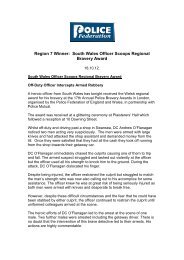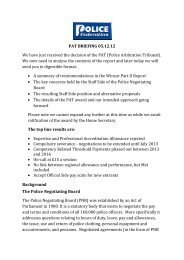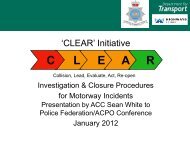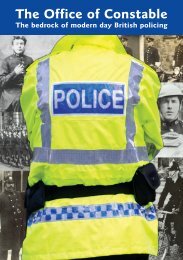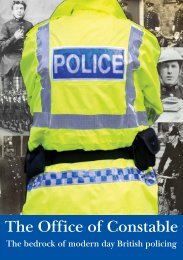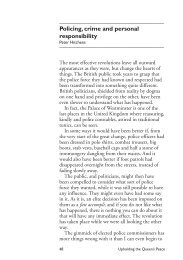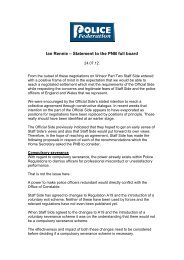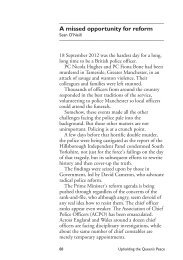THE POLICING GREEN PAPER - Police Federation
THE POLICING GREEN PAPER - Police Federation
THE POLICING GREEN PAPER - Police Federation
You also want an ePaper? Increase the reach of your titles
YUMPU automatically turns print PDFs into web optimized ePapers that Google loves.
Chapter 6:<br />
Reinforcing collaboration between forces<br />
1. What more can be done to build upon present policing arrangements to improve the<br />
security of our borders?<br />
Currently there three main policing functions at ports, who work alongside the UKBA; Special Branch is<br />
responsible for national security and counter terrorism matters, Protective Security provide policing to secure<br />
the port infrastructure and General Policing deal with crime and disorder. (Free response)<br />
• We recommend a model based on geographical forces which have responsibility for ports<br />
and airports in their own force area. Funding for such forces should be allocated centrally<br />
and officers deployed with the understanding that they should not be used for alternative<br />
duties.<br />
• Partner agencies should be encouraged to share intelligence by bringing together<br />
intelligence sources (police, HMRC and Immigration). This would streamline processes and<br />
allow analysis across the three main agencies leading to economies of staffing and opening<br />
the way to 24/7 intelligence units in larger airports and ports.<br />
• The targets that each agency works towards often conflict. For example, Gatwick airport<br />
security department has a target based on arrivals and ensuring passengers are moved<br />
through within certain time limits. The Immigration Service has a different target based on<br />
scanning all passports to read the chip that contains the biometric data. This has led to a<br />
slowdown in processing all arrivals, as their target is to scan ALL incoming passengers. This<br />
conflicts with, and frequently impacts on, the airport security target.<br />
• Examples of good practice should be disseminated to all partner agencies (e.g. one useful<br />
process that does work at Gatwick is the MATRA (Multi-agency Threat and Risk<br />
Assessment) meeting structure which brings together all of the agencies working at the<br />
airport. MATRA delivers against risks and not business area targets. In the immediate<br />
aftermath of the Glasgow terrorist incident, a number of emergency MATRA meetings were<br />
held and were able to put into place security measures which meant minimum disruption to<br />
the business of the airport.<br />
• “e-Borders” is a good idea but needs the appropriate resources to make it work. If e-Borders<br />
is linked to a PNC check, a desirable part of the process, then points of entry and exit will<br />
require investment in police and HMRC numbers as well as significant investment in custody<br />
and transport facilities. If this is not in place policing at the points of entry could be seriously<br />
hampered by lack of resources, leading to a reliance on the host force officers to deal with<br />
wanted people. It may mean a higher level of vetting for some agencies to bring them up to<br />
the level of police officers. Only police officers have the flexibility to be deployed to other<br />
locations or duties quickly and efficiently. By having police officers drawn from the host force<br />
the relationship with the force will mean that, in times of emergency, the policing operation is<br />
seamless and can be sized up to match demand. We would also like to see e-Borders<br />
developed into a crime investigation platform that disrupts criminal activity and behaviour at<br />
all levels.<br />
14



